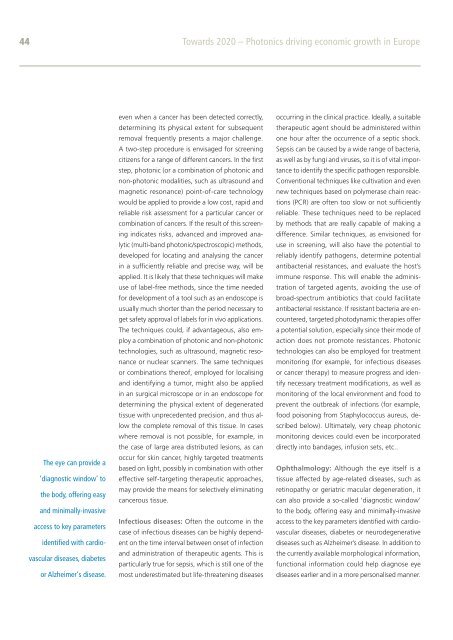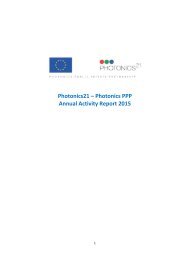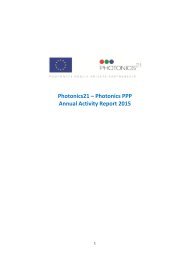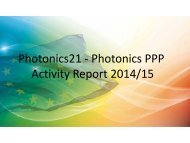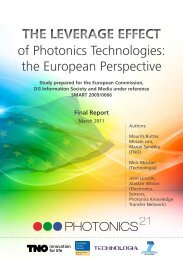Towards 2020 – Photonics driving economic growth in Europe
Create successful ePaper yourself
Turn your PDF publications into a flip-book with our unique Google optimized e-Paper software.
44 <strong>Towards</strong> <strong>2020</strong> <strong>–</strong> <strong>Photonics</strong> <strong>driv<strong>in</strong>g</strong> <strong>economic</strong> <strong>growth</strong> <strong>in</strong> <strong>Europe</strong><br />
The eye can provide a<br />
‘diagnostic w<strong>in</strong>dow’ to<br />
the body, offer<strong>in</strong>g easy<br />
and m<strong>in</strong>imally-<strong>in</strong>vasive<br />
access to key parameters<br />
identified with cardiovascular<br />
diseases, diabetes<br />
or Alzheimer‘s disease.<br />
even when a cancer has been detected correctly,<br />
determ<strong>in</strong><strong>in</strong>g its physical extent for subsequent<br />
removal frequently presents a major challenge.<br />
A two-step procedure is envisaged for screen<strong>in</strong>g<br />
citizens for a range of different cancers. In the first<br />
step, photonic (or a comb<strong>in</strong>ation of photonic and<br />
non-photonic modalities, such as ultrasound and<br />
magnetic resonance) po<strong>in</strong>t-of-care technology<br />
would be applied to provide a low cost, rapid and<br />
reliable risk assessment for a particular cancer or<br />
comb<strong>in</strong>ation of cancers. If the result of this screen<strong>in</strong>g<br />
<strong>in</strong>dicates risks, advanced and improved analytic<br />
(multi-band photonic/spectroscopic) methods,<br />
developed for locat<strong>in</strong>g and analys<strong>in</strong>g the cancer<br />
<strong>in</strong> a sufficiently reliable and precise way, will be<br />
applied. It is likely that these techniques will make<br />
use of label-free methods, s<strong>in</strong>ce the time needed<br />
for development of a tool such as an endoscope is<br />
usually much shorter than the period necessary to<br />
get safety approval of labels for <strong>in</strong> vivo applications.<br />
The techniques could, if advantageous, also employ<br />
a comb<strong>in</strong>ation of photonic and non-photonic<br />
technologies, such as ultrasound, magnetic resonance<br />
or nuclear scanners. The same techniques<br />
or comb<strong>in</strong>ations thereof, employed for localis<strong>in</strong>g<br />
and identify<strong>in</strong>g a tumor, might also be applied<br />
<strong>in</strong> an surgical microscope or <strong>in</strong> an endoscope for<br />
determ<strong>in</strong><strong>in</strong>g the physical extent of degenerated<br />
tissue with unprecedented precision, and thus allow<br />
the complete removal of this tissue. In cases<br />
where removal is not possible, for example, <strong>in</strong><br />
the case of large area distributed lesions, as can<br />
occur for sk<strong>in</strong> cancer, highly targeted treatments<br />
based on light, possibly <strong>in</strong> comb<strong>in</strong>ation with other<br />
effective self-target<strong>in</strong>g therapeutic approaches,<br />
may provide the means for selectively elim<strong>in</strong>at<strong>in</strong>g<br />
cancerous tissue.<br />
Infectious diseases: Often the outcome <strong>in</strong> the<br />
case of <strong>in</strong>fectious diseases can be highly dependent<br />
on the time <strong>in</strong>terval between onset of <strong>in</strong>fection<br />
and adm<strong>in</strong>istration of therapeutic agents. This is<br />
particularly true for sepsis, which is still one of the<br />
most underestimated but life-threaten<strong>in</strong>g diseases<br />
occurr<strong>in</strong>g <strong>in</strong> the cl<strong>in</strong>ical practice. Ideally, a suitable<br />
therapeutic agent should be adm<strong>in</strong>istered with<strong>in</strong><br />
one hour after the occurrence of a septic shock.<br />
Sepsis can be caused by a wide range of bacteria,<br />
as well as by fungi and viruses, so it is of vital importance<br />
to identify the specific pathogen responsible.<br />
Conventional techniques like cultivation and even<br />
new techniques based on polymerase cha<strong>in</strong> reactions<br />
(PCR) are often too slow or not sufficiently<br />
reliable. These techniques need to be replaced<br />
by methods that are really capable of mak<strong>in</strong>g a<br />
difference. Similar techniques, as envisioned for<br />
use <strong>in</strong> screen<strong>in</strong>g, will also have the potential to<br />
reliably identify pathogens, determ<strong>in</strong>e potential<br />
antibacterial resistances, and evaluate the host’s<br />
immune response. This will enable the adm<strong>in</strong>istration<br />
of targeted agents, avoid<strong>in</strong>g the use of<br />
broad-spectrum antibiotics that could facilitate<br />
anti bacterial resistance. If resistant bacteria are encountered,<br />
targeted photodynamic therapies offer<br />
a potential solution, especially s<strong>in</strong>ce their mode of<br />
action does not promote resistances. Photonic<br />
technologies can also be employed for treatment<br />
monitor<strong>in</strong>g (for example, for <strong>in</strong>fectious diseases<br />
or cancer therapy) to measure progress and identify<br />
necessary treatment modifications, as well as<br />
monitor<strong>in</strong>g of the local environment and food to<br />
prevent the outbreak of <strong>in</strong>fections (for example,<br />
food poison<strong>in</strong>g from Staphylococcus aureus, described<br />
below). Ultimately, very cheap photonic<br />
monitor<strong>in</strong>g devices could even be <strong>in</strong>corporated<br />
directly <strong>in</strong>to bandages, <strong>in</strong>fusion sets, etc..<br />
Ophthalmology: Although the eye itself is a<br />
tissue affected by age-related diseases, such as<br />
ret<strong>in</strong>opathy or geriatric macular degeneration, it<br />
can also provide a so-called ‘diagnostic w<strong>in</strong>dow’<br />
to the body, offer<strong>in</strong>g easy and m<strong>in</strong>imally-<strong>in</strong>vasive<br />
access to the key parameters identified with cardiovascular<br />
diseases, diabetes or neurodegenerative<br />
diseases such as Alzheimer’s disease. In addition to<br />
the currently available morphological <strong>in</strong>formation,<br />
functional <strong>in</strong>formation could help diagnose eye<br />
diseases earlier and <strong>in</strong> a more personalised manner.


